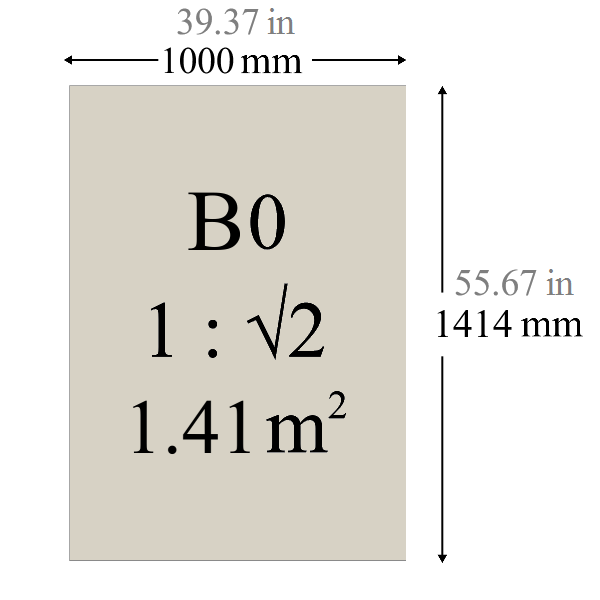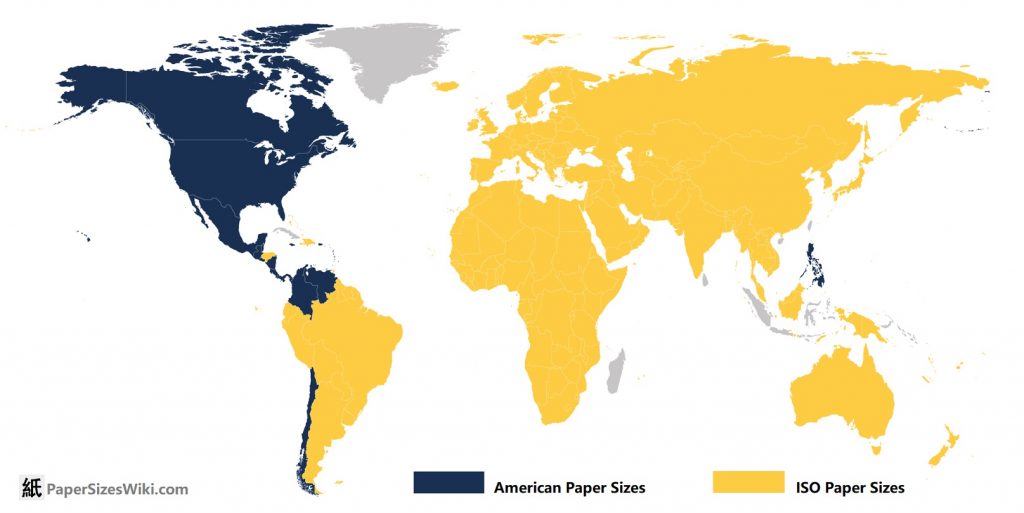What is B0 Paper Size
Definition
The B0 paper size is part of the ISO 216 international paper size standard. It is one of the largest paper sizes within the B-series, which is often used in countries that follow the metric system. The B-series is known for its unique aspect ratio, which is designed to make it easier to scale up or down while maintaining the same proportions.
Dimensions
As the largest of the ISO B paper sizes, B0 size measures 39.37 x 55.67 in inches. In most non-English speaking countries, people tend to convert the dimensions to metric for ease of understanding, so it is 1000 x 1414 in mm, or 100.0 x 141.4 in cm.
The large dimensions of B0 paper make it significantly larger than its A0 counterpart, which is also used for oversized prints but has different proportions. The B0 format offers more versatility in terms of design and layout, allowing for greater flexibility in presenting detailed content.
And it has an approximate area of 15.07 square feet or 1.414 square meters.
Layout
Below is the drawing of B0 paper size in inches and mm. It is 100.0 x 141.4 in cm.

Origin and Historical Context
The B0 paper size has its roots in the early 20th century when the International Organization for Standardization (ISO) set out to standardize paper sizes for global trade and communication. Prior to the ISO 216 system, different countries used various standards for paper sizes, making it difficult to manage paperwork, printing, and packaging on an international level. In 1922, Germany introduced the B-series as part of the DIN 476 standard, which later became the basis for the ISO 216 system adopted worldwide.
The B-series, including the B0 size, was designed with an aspect ratio of 1:√2 (approximately 1:1.414). This proportion allows a sheet of paper to be halved repeatedly to create smaller sizes, such as B1, B2, and so on, with each size maintaining the same aspect ratio. For example, B0 is the beginning of the whole series, so if you fold a B0 sheet in half, you get a B1 sheet, and if you fold a B1 sheet in half, you get a B2 sheet, and so on.
Uses of B0 Size Paper
Due to its substantial size, B0 size paper is commonly used in professional settings where size and scale are important. It offers several advantages over other paper sizes, including its large surface area, high resolution and excellent color reproduction, and other visual displays where a significant amount of information needs to be presented in a legible manner. Of course, its size also makes it an ideal choice for displaying intricate details and ensuring they are easily visible from a distance. Some of its key uses include:
- Large-Scale Prints: Designers, architects, and engineers often rely on B0 paper for blueprints and large-scale technical drawings that require a high level of detail.
- Posters and Banners: Event organizers or advertisers use B0-sized sheets for eye-catching promotional material, large posters, and banners that need to stand out in public spaces.
- Art and Photography: For artists and photographers, the B0 format offers an ideal canvas for printing high-resolution images that demand significant space for clarity and impact.
- Signage and Display Graphics: Commercial printing, advertising and other large format applications. Businesses in retail, trade shows, or exhibitions often use B0 paper for displays that need to be visible from a distance.
Given its size, the B0 paper format also has applications in educational institutions for posters, maps, and large charts used in classrooms and lectures.
Regions of Use
Countries that use ISO B0 include Japan, South Korea and some European countries. In the United States, the B-range of paper sizes is not commonly used, and there is no exact equivalent to B0 paper size.

B0 Size in cm
100.0 x 141.4 cm
B0 Size in mm
1000 x 1414 mm
B0 Dimensions Table
| Size # | in inches | in mm | in cm |
| B0 | 39.37 x 55.67 in | 1000 x 1414 mm | 100.0 x 141.4 cm |
B0 Dimensions in pixels
B0 dimensions vary in pixels, depending on the PPI/DPI applied.
| Size # |
72 dpi/ppi (screen resolution) |
96 dpi/ppi (screen resolution) |
300 dpi/ppi (print resolution) |
| B0 | 2835 x 4008 | 3780 x 5344 | 11811 x 16701 |
* PPI (pixels per inch) = DPI (dots per inch) = Resolution
Advantages & Disadvantages
Advantages
One useful aspect of the ISO 216 standard is that B0 paper is designed to be easily scalable. For example, two B1 sheets placed horizontally side by side create a B0 sheet, and two B2 sheets placed horizontally side by side create a B1 sheet. This scalability gives you the flexibility to work with different sizes while maintaining consistent proportions.
Disadvantages
Due to its large dimensions, B0 paper can be challenging to handle. Its size makes it susceptible to tearing, warping or creasing, so extra care is needed when transporting and printing. In day-to-day work, you may need professional large format printers or specialised equipment to print accurately on B0 paper. Also, the size of B0 paper may not be practical in all situations, especially for smaller applications.
B0 paper may not be as readily available as smaller standard sizes such as A4 or Letter. It is more likely to be found at specialist printers, stationery suppliers or online retailers that cater for large format printing needs.
B0 Size Equivalence in US
In the United States, the B-series paper sizes are not commonly used. Instead, the US employs the Letter (8.5 x 11 inches) and Tabloid (11 x 17 inches) sizes as standard formats for most printing and office tasks. However, the B0 paper size is often equivalent to 44 x 66 inches, which is a size used for certain types of engineering prints and larger posters.
The B0 format is also somewhat comparable in size to 36 x 48 inches, which is a common size used in architectural design prints or large format printing. However, the B0’s proportions (1:√2) make it unique, and there is no exact equivalent in US standards.
Main Facts
The B0 paper size is a critical format for large-scale prints, technical drawings, and artistic displays that require space and high levels of detail. Though not commonly found in the US, it serves as an essential format in regions where the metric system is in use. Its dimensions of 1000 x 1414 mm (39.37 x 55.67 inches) provide ample room for creating impactful designs and professional-grade prints. Understanding the B0 size is crucial for those in fields such as graphic design, architecture, and printing, where large formats are needed.